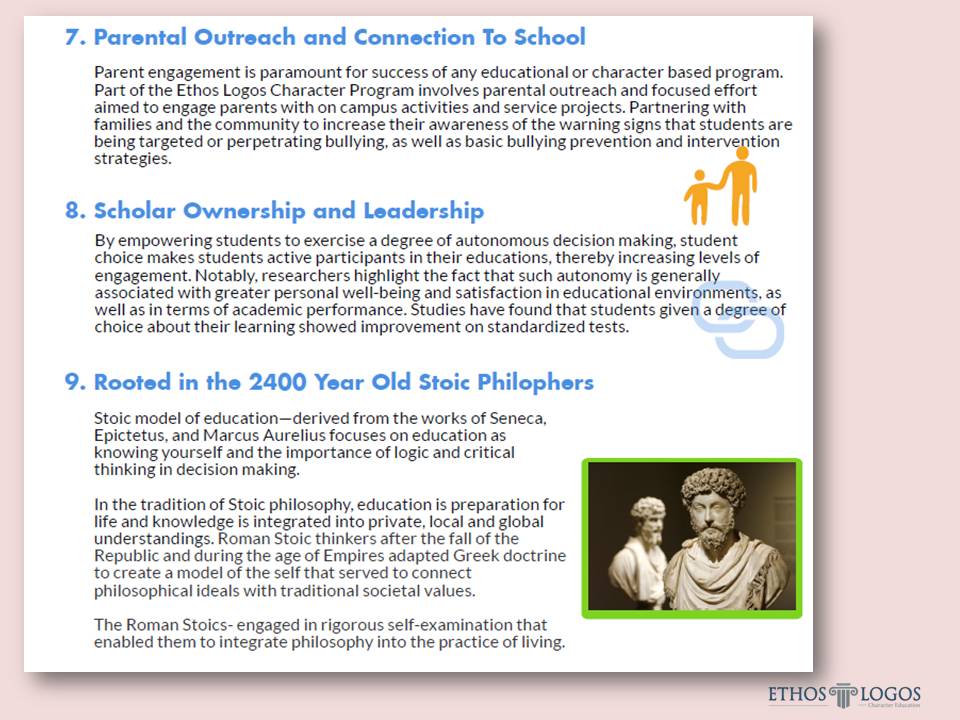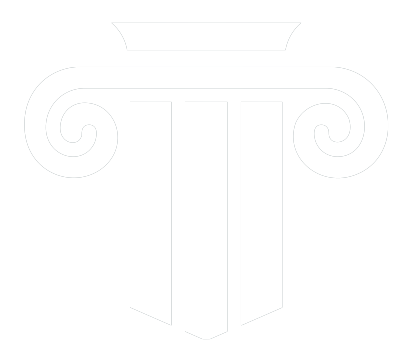Character education is the intentional effort to develop core ethics and value foundations in young people that are important to prosper in American culture.
For character education to be effective, we must work towards buy-in from all the stakeholders. From teachers and administrators to parents and scholars, a comprehensive approach must permeate all aspects of the school. From lunch rooms to classrooms, from school offices to professional development departments, character education should be on an equal footing to math and English instruction.
James Joseph Heckman, a Nobel Prize-winning American economist, has done extensive research on character, how it’s shaped, and a school's role in character development. Heckman surmised:
Character is a skill—not a trait. It can be enhanced, and there are proven and effective ways to do so. Character is shaped by families and social environments. At any age, character skills are stable across different tasks, but performance on any task depends on multiple skills as well as the effort expended on it. Effort, in turn, depends on the incentives offered to perform the task. Since all measures of character and cognition are measures of performance on some task, it is necessary to standardize for incentives, effort, and other skills in measuring any particular character or cognitive skill. Despite these difficulties, reliable measures of character have been developed, although there is always room for improvement. Though stable at any age, skills are not set in stone over the life cycle. Both cognitive and character skills can change. Parents, schools, and social environments shape them, although there are important genetic influences. Skill development is a dynamic process. The early years are important in laying the foundation for successful investment in the later years. While there is hard evidence on the importance of the early years in shaping all skills, some character skills are more malleable than cognitive skills at later ages.
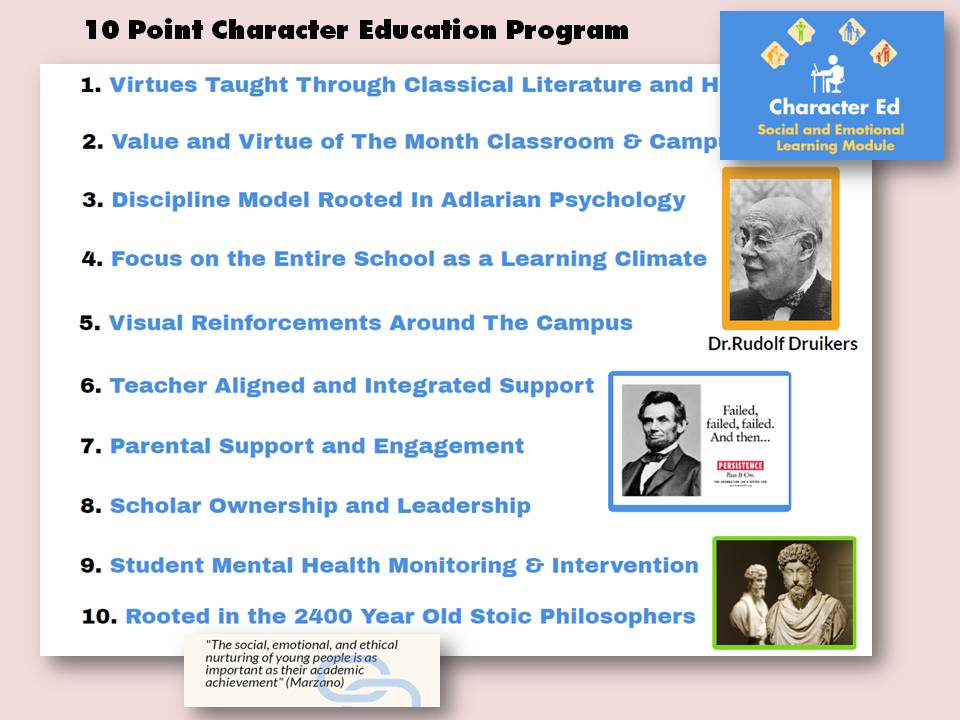
The Foundations of the Ethos Logos Character Program
The major elements of the Ethos Logos Character Program (ELCP) include research-based elements that are important to a successful program. The key elements include:
Pillar 1 -
Language-based curriculum delivered through a strong literature-based curriculum. By using the Great Books as the foundation, the Ethos Pathos Character Program expands scholar learning through the power of time-tested moral stories. Societies have used the power of stories to teach the next generation right from wrong for over 5,000 years. The expansion of vocabulary and the ability to internalize these deep rich stories into everyday life is the foundation of the ELCP program.
Pillar 2
Content and Process - Month Long Themes on Two Values/Virtues As part of the ELCP program, scholars spend intentional time with a featured value/virtue each month which is programmed into the scope and sequence of the curriculum. The in-depth analysis includes school-wide exercises and a classroom discussion on the focused value/virtue. Scholars walk through what the value/virtue means, what the alternatives are, and how their actions affect the scholars around them.
Pillar 3
Positive Language and Discipline This method uses the foundations of Dr.Rudolf Druikers and Dr. William Glasser. These two foundations are rooted in the WHY of anti-social behavior and the importance of HOW we react as a school community to poor behavior. The nuances of choices of language and the power of relationship and high expectations are the root of both philosophies.
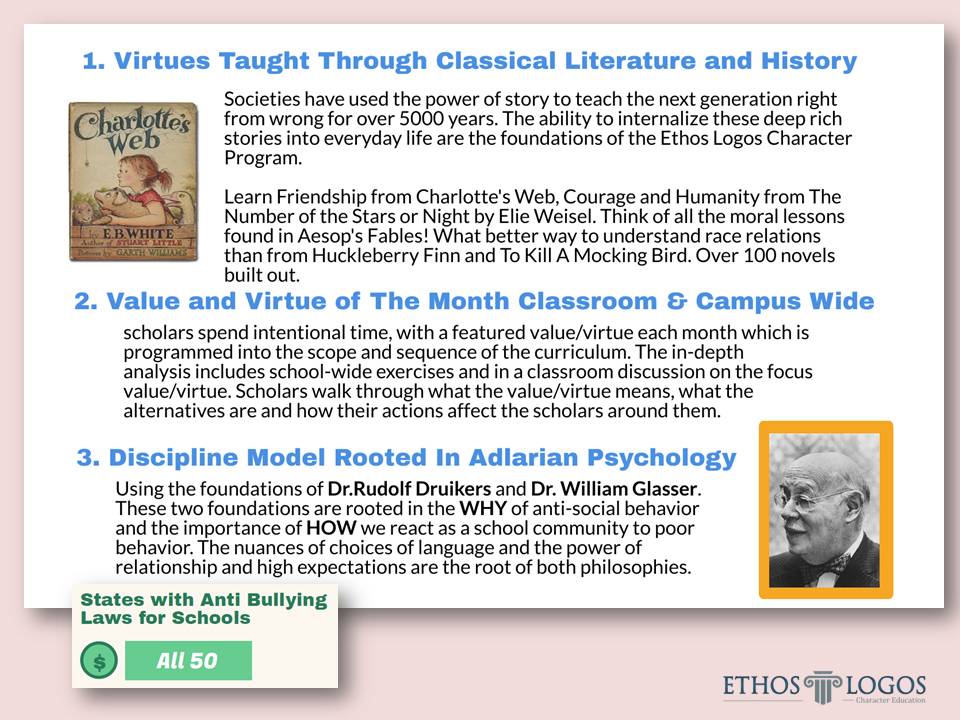
Pillar 4
School Climate Approach – A School-Wide Approach Character education and Bullying prevention do not stop in the classroom. The entire school climate. from orderly transfers in the hallways, holding of doors for other scholars or adults, the use of "please and thank you," lunchroom care, and modeling the appropriate behaviors on the playgrounds are all part of a healthy school climate. Suggestions are provided to campus leaders for school-wide programs that embed the values/virtues of the month.
Pillar 5
Visual Reinforcement As part of the roll-out of an Ethos Pathos Character Program, numerous visual reinforcements in the classroom, on the hallway walls, and on lunchroom and play areas are an important reminder of what the school holds as important. Visuals are custom designed to tie in with the famous stories from history which are studied in the classrooms to reinforce character messages. A partnership with Values.com also provides more specific options of visual reinforcements for schools with different socio-economic issues or specific issues that need to be addressed.
Pillar 6
Teacher Aligned and Integrated Support Materials The ELCP program has lesson plans, campus-wide programs as standalone modules or for maximum impact embedded in the traditional ELA, History and Science, and Common Core-aligned lessons. The curriculum embedded approach allows teachers and scholars to move seamlessly through standards and character instruction. A subset of the support materials and scope and sequence is a High Degree of Teacher Flexibility. No one knows their scholars and what the classroom needs moment by moment better than the teacher in the classroom.
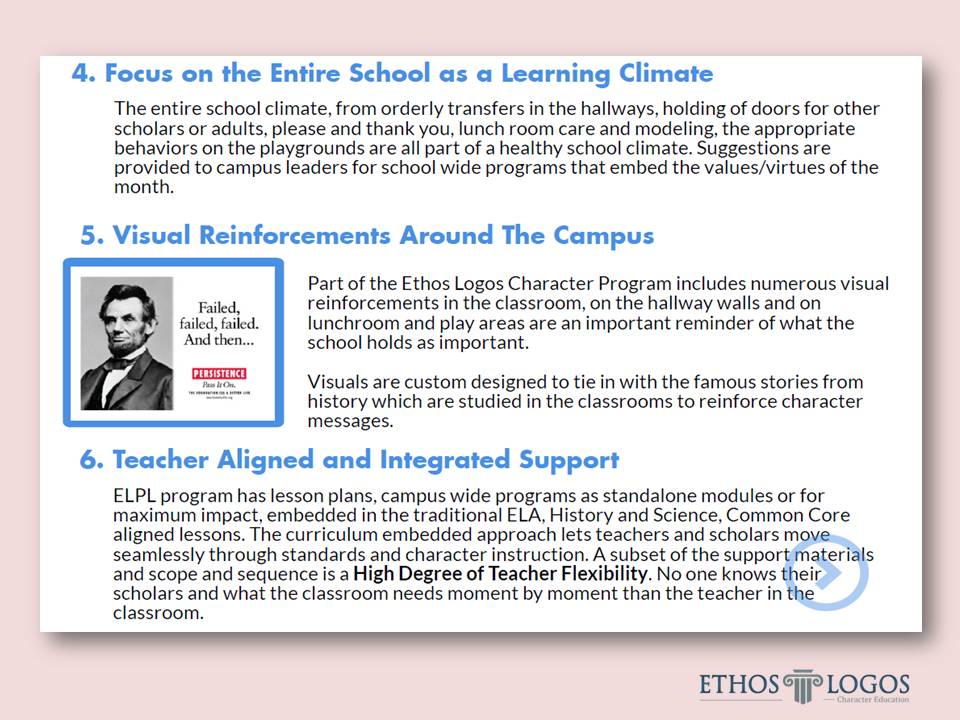
Pillar 7
Parental Involvement In School Character Education Parent engagement is paramount for the success of any educational or character-based program. Part of the Ethos Logos Character Program involves parental outreach and focused efforts aimed to engage parents with on-campus activities and service projects. Partnering with families and the community to increase their awareness of the warning signs that students are being targeted or perpetrating bullying, as well as basic bullying prevention and intervention strategies. Research has found reductions in bullying for secondary students may be due to the adult-facilitated approach of many bullying prevention programs (Yeager, Fong, Lee, & Espelage, 2015).
Pillar 8
Scholar Ownership Into the Character Program The study of growth mindset and engagement of students in their learning has shown promising results in increasing student outcomes, rising above socio-economic or home life challenges, and creating a sense of belonging on a school campus. Student choice is considered to have a similar set of benefits to those associated with personalized learning. In particular, by empowering students to exercise a degree of autonomous decision making, student choice makes students active participants in their education, thereby increasing levels of engagement. Notably, researchers highlight the fact that such autonomy is generally associated with greater personal well‐being and satisfaction in educational environments, as well as in terms of academic performance. Studies have found that students who are given a degree of choice about their learning showed improvement on standardized tests.
Pillar 9
Foundations Rooted in Stoic Philosophy Stoic model of education—derived from the works of Seneca, Epictetus, and Aurelius focuses on education as knowing yourself and the importance of logic and critical thinking in decision making. In the tradition of Stoic philosophy, education is a preparation for life, and knowledge is integrated into private, local, and global understandings. Roman Stoic thinkers after the fall of the Republic and during the age of Empires adapted Greek doctrine to create a model of the self that served to connect philosophical ideals with traditional societal values. The Roman Stoics engaged in rigorous self-examination that enabled them to integrate philosophy into the practice of living.
